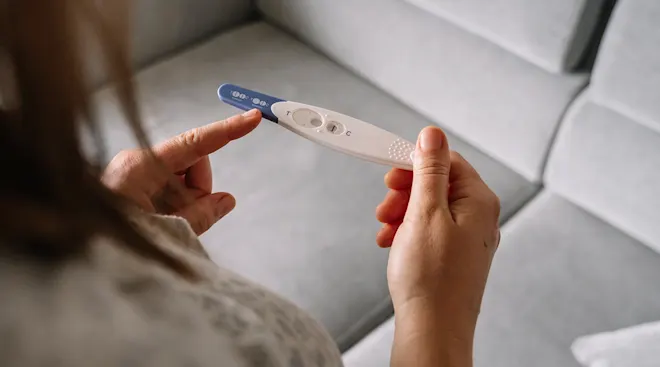Blighted Ovum: What Does It Mean to Have an Anembryonic Pregnancy?
Finding out you’re expecting is incredibly exciting, and you may be waiting with bated breath for that first prenatal appointment. Of course, it can be absolutely gut-wrenching to visit your OB or midwife and learn that your pregnancy isn’t viable. Early pregnancy loss is common and happens for various reasons; one potential cause is a blighted ovum. If you’ve been diagnosed with a blighted ovum—also sometimes referred to as anembryonic gestation or an anembryonic pregnancy—you probably need some time to process your loss. You also likely have lots of questions about what, exactly, it means to have a blighted ovum and any potential impact this may have on future pregnancies. From blighted ovum symptoms and diagnosis to what to expect during and after a miscarriage, here’s everything you need to know.
First and foremost, what is a blighted ovum and why does it happen? Blighted ovum means a “damaged egg,” says Jonathan Schaffir, MD, an ob-gyn at the Ohio State University Wexner Medical Center. It happens when an embryo never develops or stops developing, leaving an empty gestational sac. “With a blighted ovum, the embryo attached to the uterine wall but didn’t grow,” explains Christine Greves, MD, an ob-gyn at the Winnie Palmer Hospital for Women & Babies in Orlando, Florida. In the case of an anembryonic pregnancy, the placenta can continue to develop for a short while without the presence of a baby, and pregnancy hormones may continue to accumulate in your system.
How common is a blighted ovum?
Blighted ovums are “grouped under early pregnancy loss,” notes Greves. And given that early pregnancy loss is often missed entirely, it’s difficult to know just how common they are, she adds. According to the American College of Obstetricians and Gynecologists (ACOG), about 10 percent of known pregnancies end in early pregnancy loss. Moreover, the American Pregnancy Association estimates that 50 percent of early miscarriages are caused by a blighted ovum.
It’s natural to want an explanation for what’s happening in your body. Unfortunately, if you’re wondering what causes a blighted ovum, the answer is far from definitive. “It’s hard to say, as with any miscarriage, and there are probably a number of potential causes,” Schaffir says. According to the ACOG, about half of all early pregnancy losses are caused by a random event where the embryo receives an abnormal number of chromosomes, the structures inside cells that carry genes. An embryo receives chromosomes from the sperm and the egg, and if either contributor has an abnormal number of chromosomes, the embryo will have an abnormal number too and the pregnancy will not progress.
It can be difficult to know if you have a blighted ovum without seeing your doctor. Since the placenta can still grow, your level of the pregnancy hormone human chorionic gonadotropin (hCG) may continue to rise for a period of time, which could lead to traditional pregnancy symptoms like morning sickness, Greves says. Your discharge could also be normal. “You may notice nothing initially,” she adds.
But if your body has already started trying to pass the blighted ovum, you may experience some blighted ovum symptoms or a few signs of early miscarriage, including bleeding and cramping, Greves says. (Just don’t automatically assume that those symptoms mean you have a blighted ovum—some bleeding and cramping in early pregnancy is relatively common and doesn’t necessarily indicate that anything is wrong.)
To diagnose a blighted ovum, ultrasound is necessary. This will usually happen around six weeks, Greves says. At that point, you should be able to see a fetal heartbeat and other characteristics of a growing fetus on the radar, she explains. In the absence of these things at six or more weeks, your doctor may determine you’ve miscarried; and if there’s an empty sac, they may even confirm it’s an anembryonic pregnancy.
Can a blighted ovum be misdiagnosed?
It’s possible for a blighted ovum to be misdiagnosed if the dating is off with your pregnancy, Schaffir says—meaning, you think you’re six or seven weeks along but you’re actually five or less weeks into your pregnancy. “If the pregnancy is detected on an ultrasound very early, there might only be a sac without an embryo present,” he says. It might just be too soon to detect these things. However, “once it gets to a certain size and no embryo has appeared, it’s not a viable pregnancy.”
Blighted ovum hCG levels can remain elevated for a bit, so depending on your situation, your doctor may wait a few days, retest your hCG and perform another ultrasound.
Getting the news that you have a blighted ovum can be devastating. There is some variation with how the miscarriage moves forward, though, and you may have some options.
At what stage do blighted ovums usually miscarry?
Blighted ovums typically miscarry early in the pregnancy, and your body may simply pass the tissue naturally. While it typically occurs on the earlier side, it can happen any time between weeks six and 13, so your doctor will give you options for next steps, including waiting to let your body pass the tissue on its own, which can take up to two weeks. This will typically involve bleeding that’s heavier and lasts longer than your usual period. You may also experience some cramping, pain, diarrhea and nausea.
In some instances, a medical procedure or treatment may be necessary or helpful to expedite the process. This could include vacuum aspiration, where a thin tube is inserted into your uterus to remove the tissue, or a dilation and curettage (D&C), where your cervix is dilated and an instrument is used to remove the pregnancy tissue. Medication to make the pregnancy tissue pass is also often an option, Schaffir says.
Talk to your doctor to decide together how to proceed. “Some women want to have a D&C or medication to make the pregnancy pass, just in order to have the experience be over as soon as possible, but some rather let things happen naturally on their own,” Schaffir says.
During recovery, avoid putting anything into your vagina for one to two weeks after your loss to help prevent infection. If you develop heavy bleeding (soaking more than two maxi pads an hour for more than two hours in a row), a fever, chills or severe pain, call your doctor right away.
Going through anembryonic pregnancy can be emotionally difficult, and seeking out support or counseling can be beneficial. Give yourself time and space to grieve, but don’t think that you have to face this alone. Share: Pregnancy & Infant Loss Support can help you find local support groups and online resources to help you heal, physically and mentally.
It’s physically possible to ovulate and become pregnant as soon as two weeks after an early pregnancy loss, according to the ACOG. Your body or mind may need more time, though, and that’s okay too. Talk to your doctor to get more specific guidance. While it’s understandable to be nervous, Schaffir says that it’s “very likely” you’ll go on to have a healthy pregnancy. After all, he explains, after a single miscarriage, the chance of having another is the same as before you had a blighted ovum.
About the experts:
Christine Greves, MD, is an ob-gyn at the Winnie Palmer Hospital for Women & Babies in Orlando, Florida. She received her medical degree from the University of South Florida College of Medicine where she also completed her residency.
Jonathan Schaffir, MD, is an ob-gyn at the Ohio State University Wexner Medical Center. He received his medical degree from Brown University in Providence, Rhode Island.
Please note: The Bump and the materials and information it contains are not intended to, and do not constitute, medical or other health advice or diagnosis and should not be used as such. You should always consult with a qualified physician or health professional about your specific circumstances.
Plus, more from The Bump:
Navigate forward to interact with the calendar and select a date. Press the question mark key to get the keyboard shortcuts for changing dates.



















































